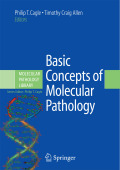
Over the past two decades there has been an explosion in knowledge about the molecular pathology of human diseases which accelerated with the sequencing ofthe human genome in 2003. Molecular diagnostics and molecular targeted therapy have contributed to the current concept of personalized patient care that isnow routine in many medical centers. As a result, general and subspecialty pathologists, clinical practitioners of all types and radiologists must now havean understanding of the basic concepts of molecular pathology and their role in new diagnostic and therapeutic applications to patient care. The Molecular Pathology Library series was created to bridge the gap between traditional basic science textbooks in molecular biology and traditional medical textbooks for organ-specific diseases. Practical introduction to molecular pathology Emphasis on practical applications Visual approach includes an abundance of tables and diagrams INDICE: Genes, Gene Products, and Transcription Factors.- Receptors, Signaling Pathways, Cell Cycle, and DNA Damage Repair.- Cell Adhesion Molecules.- Apoptosis and Cell Death.- Mutations and Epimutations.- Bioinformatics and Omics.- General Approach to Molecular Pathology.- Applications of Molecular Tests in Anatomic Pathology.- Polymerase Chain Reaction and Reverse Transcription-Polymerase Chain Reaction.- Array Comparative Genomic Hybridization in Pathology.- Loss of Heterozygosity.- In Situ Hybridization.- Proteomics.- Immunohistochemistry of Biomarkers.- Flow Cytometry.- Stem Cells.- Animal Models of Disease.- Tissue Culture Models.- Index.
- ISBN: 978-0-387-89625-0
- Editorial: Springer
- Encuadernacion: Rústica
- Páginas: 225
- Fecha Publicación: 01/07/2009
- Nº Volúmenes: 1
- Idioma: Inglés
